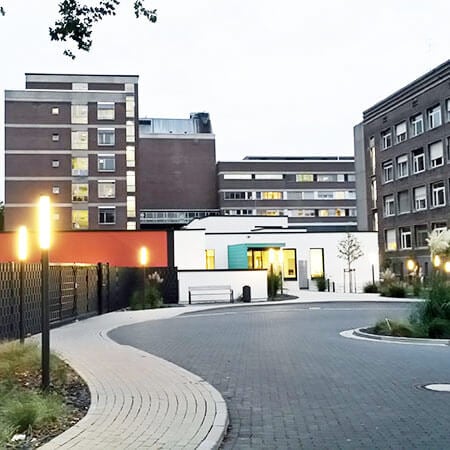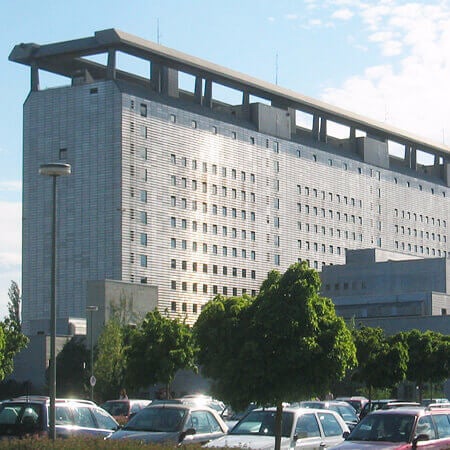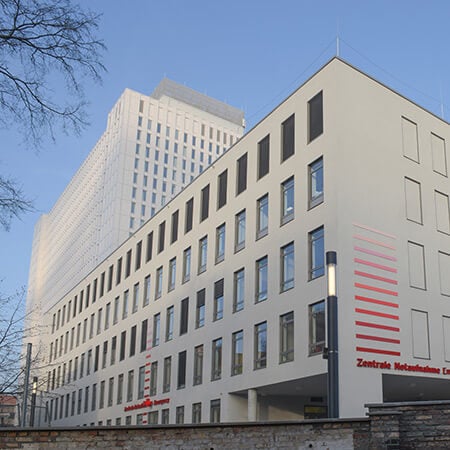Umbilical hernia (Exomphalos)
Due to the difficulties associated with the organization of treatment in Turkey, Switzerland, South Korea and India, we are not currently processing requests to these regions.
If you are interested in treatment in Germany, please leave a request and our specialists will contact you as soon as possible.
Umbilical hernia is a type of hernia of the anterior abdominal wall when organs of the abdominal cavity protrude into the subcutaneous tissue through the umbilical ring. The disease occurs in children and adults. It accounts for about 5% of all the abdominal hernias. Umbilical hernia is 8 times more common among children of Asian and African races compared to the Europeans. Risk group of the adult patients includes women over the age of 30 years who had several pregnancies in their medical history.
The Booking Health portal presents 44 German clinics specializing in umbilical hernia (exomphalos) treatment
Show all clinics
Umbilical hernia – Diagnostics
A clinical examination of the patient is sufficient for establishing the diagnosis. The instrumental diagnostics methods help doctor to:
- Assess the size of the herniated defect
- Identify the contents of the hernia sac
- Detect the adhesive process
Ultrasound is usually performed for this purpose. Sometimes it may be necessary to carry out hernography – radiographic examination with contrast agent.
Best clinics for the umbilical hernia diagnostics in Germany:
Umbilical hernia – Treatment
In children hernia can go away by itself. That’s why during the first years of life, patients are provided with conservative therapy only. It includes the usage of patches, bands, and bandages that prevent hernia sac from protrusion through the developed defect.
Physical therapy and massage are usually recommended for anterior abdominal wall strengthening.
Further, three outcomes are possible:
- Cure. Hernia disappears by itself among in kids under the age of 4-5.
- Hernia doesn’t reduce. Surgical treatment is performed. If hernia is up to 1 cm in size, the surgery is performed when the child is 6 years old. If the diameter is over 1 cm, surgery is performed when the child is 4 years old. If there is a large herniated defect more than 1.5 cm in diameter with a proboscis herniated protrusion, the surgery should be performed during the second year of the child’s life.
- Hernia is incarcerated. In this case, surgery is indicated regardless of age, including newborns.
Hernia sac is set during the surgery and the defect is fixed. It can be done in different ways. There are surgeries with pulling and without it. When performing the procedure with pulling, the defect is closed by patient’s own tissues. Synthetic meshes are applied during operations without pulling. If a hernia sac cannot be set to the place, it’s being excised and ligated.
Laparoscopy is possible in the number of cases. A doctor can also use a synthetic mesh. Laparoscopy is performed through the small incisions that shortens the rehabilitation period and lowers the risk of complications. But, the procedure is only possible for the reducible hernias when a defect has a small size.
Umbilical hernia – Rehabilitation
Rehabilitation is the process of body restoration from injuries, surgeries or diseases. It is indicated for patients after conservative and surgical treatment of the internal organs diseases.
The directions of the general therapeutic rehabilitation
There are several main directions of the therapeutic rehabilitation such as:
- Medical one, which includes the restoration of patient's health, normalization of body functions, stimulation of compensatory possibilities, elimination of the chronic pain, etc.
- Physical one, which is responsible for improving of work capacity and tolerance for physical activities.
- Psychological one, which helps to eliminate the mental disorders which may occur as a result of a disease (phobias, depression, apathy), to increase the human motivation, and to adapt to the changed living conditions.
Therapeutic rehabilitation methods
The most modern rehabilitation programs are used in Germany. They are adapted individually for each patient, and are based on the recent disease, age, physical possibilities, and the results of treatment. Different specialists such as: therapists, surgeons, physiotherapists, psychologists are involved in the rehabilitation process.
The following methods of rehabilitation are used:
- Dosed physical activity (for normalization of body weight)
- Training on the simulators and in the pool
- Physiotherapy
- Natural factors of the nature (mud, thermal waters, etc.)
Also, it is necessary to hold a consultation with the patient about the proper nutrition and the way of life which is important for him in the current situation.
Rehabilitation programs in Germany are designed for 2 weeks. If necessary, they can last much longer. In this country, the patient is provided with qualitative care, accommodation in comfortable rooms and individually selected meals.
Rehabilitation programs in Germany show one of the best results in the world. Most patients successfully restore their employability and excellent health there. They remain physically active, return to the full social and family life.
Best clinics for general therapeutic rehabilitation in Germany:
Authors:
The article was edited by medical expert, board certified Dr. Nadezhda Ivanisova. For the treatment of the conditions referred to in the article you must consult a doctor; the information in the article is not intended for self-medication!
Sources:
The cost of services includes
Here you can find the cost of treatment for this disease at the German University Hospitals. Leave a request and we will provide a free consultation with a doctor and will start organizing the whole treatment process.
The program includes the following:
- Issuing of an invitation for getting a visa for treatment as quick as possible
- Fixing an appointment at a time convenient for you
- Preliminary organization of a comprehensive examination and discussion of the forthcoming treatment plan
- Arranging transfer from the airport to the hospital and back to the airport
- Provision of interpreting services and services of a personal medical coordinator
- If necessary, assistance in the organization of further surgical treatment
- Provision of a medical insurance against treatment complications covering up to 200,000 euro
- Preparation and translation of medical records and recommendations from the hospital
- Assistance in the subsequent communication with your attending physician, including consultations on repeated X-ray images through the unique medical document management system E-doc





